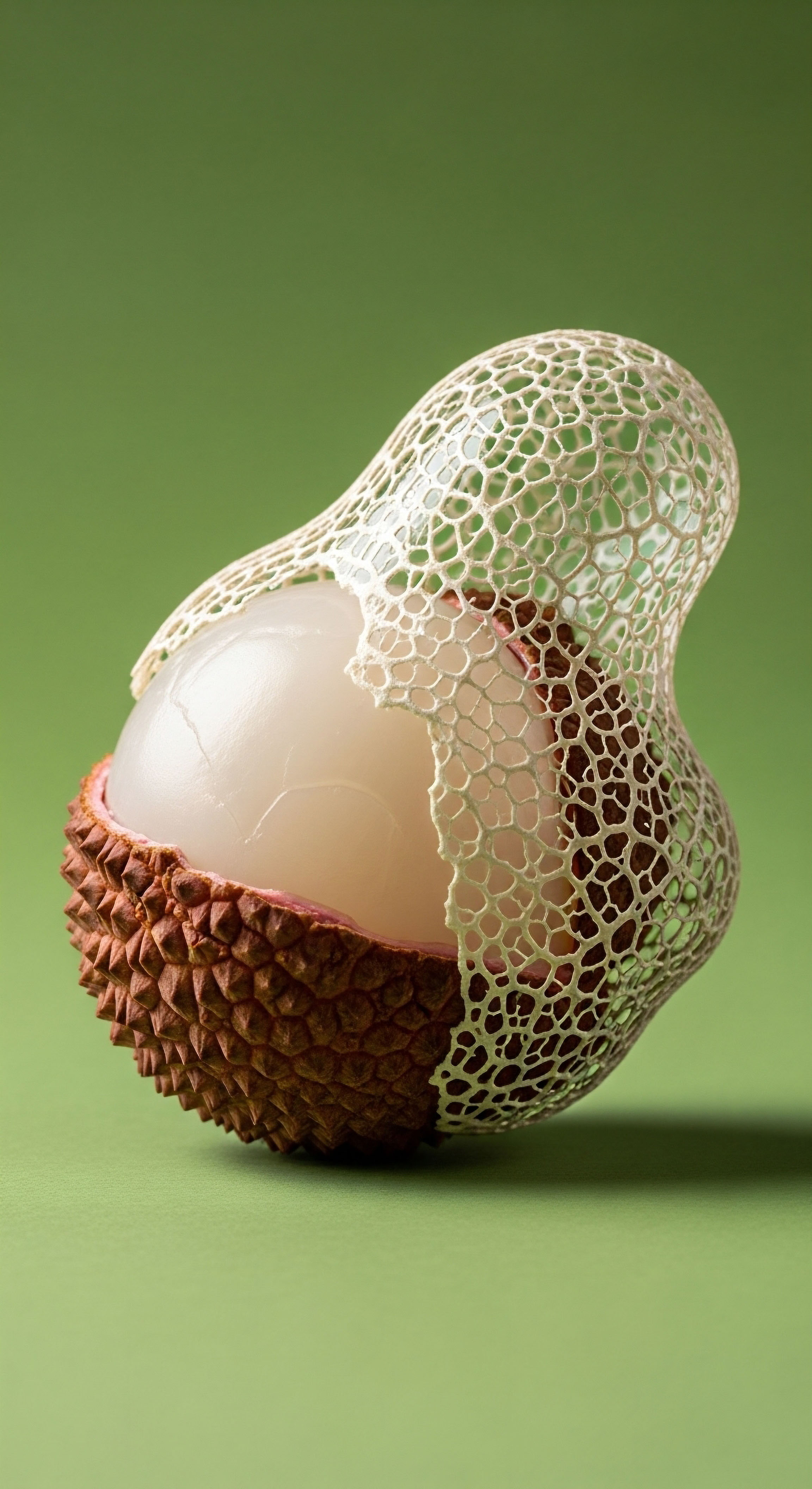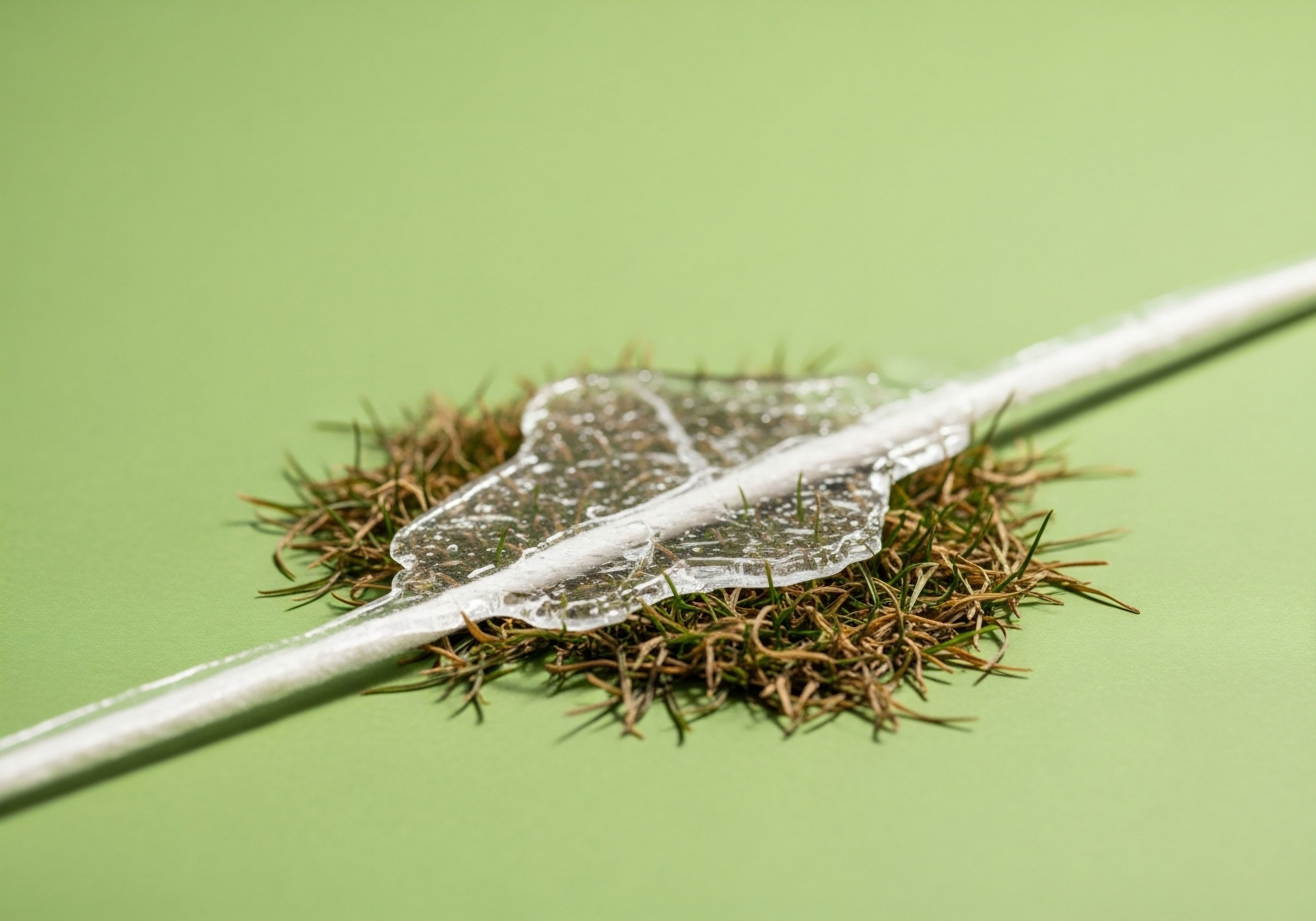

Fundamentals
Initiating a protocol to optimize your testosterone levels is a profound step toward reclaiming vitality. It is a decision rooted in the desire to feel, function, and live at your peak potential. As your body begins to recalibrate, you may observe a range of physiological shifts, and for some, this includes changes in hair.
This experience is a direct line of communication from your body, signaling a complex and fascinating biological process at the follicular level. Understanding this process is the first step in addressing it, transforming concern into empowered action.
The central mechanism at play involves the relationship between testosterone and another potent androgen, dihydrotestosterone (DHT). Your body, in its intricate wisdom, uses an enzyme called 5-alpha-reductase to convert a portion of testosterone into DHT. This conversion is a normal and necessary process for many aspects of male physiology.
However, for individuals with a genetic predisposition to androgenetic alopecia (male or female pattern hair loss), the hair follicles on the scalp possess a heightened sensitivity to DHT’s effects. When DHT binds to these genetically sensitive receptors, it triggers a process called follicular miniaturization.
This causes the hair follicle to shrink, shortening the growth phase (anagen) of the hair cycle. Over time, the follicles produce progressively finer, shorter, and less pigmented hairs, eventually leading to the characteristic patterns of hair thinning.
The sensitivity of your hair follicles to the hormone DHT, a byproduct of testosterone, is the primary determinant of androgen-related hair changes.
This entire process is deeply personal and genetically mediated. It explains why two individuals on identical testosterone optimization protocols can have vastly different experiences with their hair. One may notice no change, while the other observes accelerated thinning. The variable is not the testosterone itself, but the inherited sensitivity of the hair follicles.
This genetic blueprint dictates how the follicles will respond to the hormonal environment. Recognizing this individuality is key. The journey is about understanding your unique biology and learning how to support it intelligently through targeted lifestyle and dietary strategies.

The Hair Growth Cycle under Hormonal Influence
Your hair is in a constant, dynamic cycle of growth, transition, and rest. Appreciating these phases provides a clear window into how hormonal shifts exert their influence.
- The Anagen Phase This is the active growth phase. Cells in the hair bulb divide rapidly to form the hair shaft. This phase can last anywhere from two to seven years, determining the maximum length of your hair. Hormonal balance is critical for maintaining a robust anagen phase.
- The Catagen Phase A short, transitional phase lasting only a few weeks. During this time, the hair follicle begins to shrink and detaches from its blood supply, signaling the end of active growth.
- The Telogen Phase This is the resting phase, which lasts for about three months. The hair shaft is dormant, and a new hair begins to grow beneath it. The old hair is eventually shed to make way for the new one.
In individuals with androgenetic alopecia, elevated DHT levels effectively shorten the anagen phase and extend the telogen phase. This disruption means more hairs are shedding or resting than are actively growing, leading to a gradual reduction in overall hair density. The goal of any supportive strategy is to help protect the anagen phase and mitigate the follicular miniaturization prompted by DHT.


Intermediate
Understanding that follicular sensitivity to DHT is the core mechanism of hair changes during testosterone therapy allows us to move into a proactive, strategic mindset. The focus shifts from the hormone itself to modulating the environment in which it operates. This is where targeted dietary and lifestyle interventions become powerful tools. By influencing key enzymatic pathways and reducing systemic inflammation, you can create a biological terrain that is more resilient to the effects of DHT on sensitive follicles.

Targeting the 5-Alpha-Reductase Enzyme through Nutrition
The conversion of testosterone to DHT is catalyzed by the 5-alpha-reductase (5-AR) enzyme. Logically, mitigating the activity of this enzyme can lead to lower levels of DHT at the scalp. While pharmaceutical 5-AR inhibitors like finasteride exist, a nutritional approach can offer a supportive, foundational layer of defense. Certain foods contain phytochemicals that have been studied for their potential to naturally inhibit 5-AR activity.
Incorporating these foods into your daily diet can be a powerful, long-term strategy. These compounds work synergistically, offering benefits that extend beyond hair health to overall systemic wellness. For instance, the anti-inflammatory properties of many of these foods can help address another key factor in hair loss ∞ perifollicular inflammation.

Key Dietary Components and Their Mechanisms
- Phytosterols Found in high concentrations in pumpkin seed oil and saw palmetto, phytosterols like beta-sitosterol are structurally similar to cholesterol and have been shown to possess mild 5-AR inhibitory properties. They are a cornerstone of many natural protocols for prostate health, which is also a DHT-driven condition.
- Polyphenols This broad class of antioxidants, abundant in green tea (especially EGCG), coffee, and dark berries, offers a dual benefit. They can exert a mild inhibitory effect on 5-AR while also combating oxidative stress, which can damage hair follicles.
- Lignans Flaxseeds are a particularly rich source of lignans, which are converted by gut bacteria into enterolactone and enterodiol. These compounds have been shown to modulate hormone metabolism and may help reduce DHT bioavailability.
- Zinc This essential mineral plays a complex role. While severe deficiency is linked to hair loss, adequate levels are necessary for hair health. Some research suggests that zinc can inhibit 5-AR activity, helping to maintain a healthier testosterone-to-DHT ratio.

How Can Lifestyle Choices Protect Hair Follicles?
Your daily habits create the systemic environment that can either amplify or buffer the genetic predisposition to hair loss. Stress, in particular, is a potent accelerant of follicular damage through distinct biochemical pathways.
Chronic stress elevates cortisol, a catabolic hormone that can prematurely shift hair follicles from the anagen (growth) phase into the telogen (shedding) phase, a condition known as telogen effluvium. This can compound the effects of androgenetic alopecia. Furthermore, stress promotes neurogenic inflammation, where stress signals themselves trigger the release of inflammatory mediators directly at the hair follicle, creating a hostile environment for growth. Therefore, a disciplined approach to stress management is a non-negotiable component of any hair-supportive protocol.
| Intervention | Primary Mechanism of Action | Biological Effect |
|---|---|---|
| Stress Reduction (Meditation, Breathwork) | Downregulation of the HPA Axis |
Lowers systemic cortisol levels, reducing the premature shift of follicles into the telogen phase. Decreases neurogenic inflammation around the follicle. |
| Consistent, High-Quality Sleep | Hormonal Regulation and Cellular Repair |
Optimizes overnight growth hormone release, which is crucial for cellular regeneration, including the cells of the hair follicle. Stabilizes cortisol rhythms. |
| Regular Physical Exercise | Improved Circulation and Insulin Sensitivity |
Enhances blood flow, delivering more oxygen and nutrients to the scalp. Improved insulin sensitivity helps reduce low-grade inflammation throughout the body. |
| Scalp Massage | Mechanical Stimulation and Blood Flow |
Directly increases circulation to the hair follicles and may help to reduce localized scalp tension, creating a better environment for hair growth. |
By integrating these dietary and lifestyle strategies, you are not merely treating a symptom. You are actively cultivating a systemic environment that supports hormonal balance, reduces inflammation, and provides your hair follicles with the resources they need to withstand the influence of DHT.


Academic
A sophisticated approach to mitigating hair changes associated with testosterone optimization protocols requires a granular understanding of the cellular and molecular dialogues occurring within the dermal papilla and perifollicular space. The conversation moves beyond the simple T-to-DHT conversion and into the realm of genetic expression, inflammatory signaling, and micronutrient-level enzymatic modulation. The central challenge lies in influencing the local tissue environment of the scalp to be less permissive to the miniaturizing signals of androgens.

The Androgen Receptor and Genetic Sensitivity
The biological activity of DHT is contingent upon its binding to the Androgen Receptor (AR), a protein encoded by the AR gene. The genetic variations (polymorphisms) within this gene are a primary determinant of androgenetic alopecia.
These variations can increase the density of ARs in scalp follicles or enhance the stability of the DHT-AR complex, leading to a more potent downstream signal cascade even with normal circulating androgen levels. Testosterone therapy can amplify this pre-existing sensitivity by increasing the availability of the ligand (DHT).
The genetic expression of the androgen receptor within scalp follicles dictates the ultimate biological response to circulating dihydrotestosterone.
This DHT-AR complex acts as a transcription factor. Once activated, it translocates to the cell nucleus and binds to specific DNA sequences known as androgen response elements. This action modulates the expression of various genes responsible for the hair growth cycle.
Critically, it upregulates genes that produce TGF-β2 (Transforming Growth Factor beta 2), a cytokine that promotes the transition from the anagen to the catagen phase, effectively telling the hair to stop growing. Simultaneously, it shortens the anagen phase itself, leading to the progressive miniaturization that defines this condition.

Perifollicular Inflammation and Fibrosis
While androgenetics provides the foundational susceptibility, a state of sustained, low-grade microscopic inflammation in the perifollicular region is now considered a significant cofactor in the progression of hair loss. This inflammatory infiltrate, often rich in activated T-cells and macrophages, is observed around the lower follicle in individuals with AGA.
This micro-inflammation can be triggered and exacerbated by several factors, including oxidative stress, environmental pollutants, and the release of pro-inflammatory cytokines induced by the DHT-AR complex itself.
This chronic inflammatory state contributes to the eventual scarring of the follicle. It promotes the deposition of a perifollicular collagen sheath, a process known as fibrosis. This fibrotic tissue gradually replaces healthy follicular structures, impeding nutrient delivery and ultimately leading to the irreversible loss of the follicle’s ability to produce hair. Dietary and lifestyle interventions, therefore, should be viewed through the lens of their anti-inflammatory and anti-fibrotic potential.
| Compound | Primary Source | Proposed Mechanism of Action |
|---|---|---|
| Epigallocatechin gallate (EGCG) | Green Tea |
A potent antioxidant that may inhibit 5-alpha-reductase activity. It also helps counteract oxidative stress within the dermal papilla cells, protecting them from inflammatory damage. |
| Curcumin | Turmeric |
A powerful anti-inflammatory agent that downregulates NF-κB, a key transcription factor involved in inflammatory responses. May help mitigate the perifollicular inflammation associated with AGA. |
| Resveratrol | Grapes, Berries |
Exhibits anti-inflammatory and antioxidant properties. Some research suggests it can modulate androgen receptor expression and activity, potentially reducing the impact of DHT on the follicle. |
| Astaxanthin | Microalgae, Salmon |
A carotenoid with significant antioxidant and 5-AR inhibitory potential, helping to protect the follicle from both oxidative damage and the effects of DHT. |
What is the most effective nutritional strategy to reduce scalp inflammation? The most effective strategy involves a multi-pronged approach that combines the intake of specific phytochemicals with a foundational anti-inflammatory diet, such as one rich in omega-3 fatty acids and low in processed carbohydrates and industrial seed oils.
This systemic approach reduces the overall inflammatory burden, creating a more favorable environment for follicular health. The goal is to modulate the biochemical milieu of the scalp, making it more resilient to both androgenic signaling and inflammatory insults, thereby preserving follicular function for as long as possible.

References
- Trüeb, R. M. “Molecular mechanisms of androgenetic alopecia.” Experimental Gerontology, vol. 37, no. 8-9, 2002, pp. 981-90.
- Zito, Patrick M. and Karlyle G. Bistas. “Androgenetic Alopecia.” StatPearls, StatPearls Publishing, 2023.
- Adil, A. & Godwin, M. “The effectiveness of treatments for androgenetic alopecia ∞ A systematic review and meta-analysis.” Journal of the American Academy of Dermatology, vol. 77, no. 1, 2017, pp. 136-141.e5.
- Prager, N. et al. “A randomized, double-blind, placebo-controlled trial to determine the effectiveness of botanically derived inhibitors of 5-alpha-reductase in the treatment of androgenetic alopecia.” The Journal of Alternative and Complementary Medicine, vol. 8, no. 2, 2002, pp. 143-52.
- Bang, H. J. et al. “The role of the androgen receptor in the pathogenesis of androgenetic alopecia.” International Journal of Dermatology, vol. 43, no. 8, 2004, pp. 573-8.
- Inui, S. & Itami, S. “Androgen actions on the human hair follicle ∞ perspectives.” Experimental Dermatology, vol. 22, no. 3, 2013, pp. 168-71.
- Paus, R. & Cotsarelis, G. “The biology of hair follicles.” The New England Journal of Medicine, vol. 341, no. 7, 1999, pp. 491-7.
- Chen, X. et al. “Stress-induced neuroinflammation and its role in hair loss.” Journal of Dermatological Science, vol. 98, no. 2, 2020, pp. 78-85.
- Azzouni, F. et al. “The 5 alpha-reductase isozyme family ∞ a review of basic research and clinical implications.” The Journal of Urology, vol. 187, no. 2, 2012, pp. 383-8.
- Rossi, A. et al. “The role of nutrition in hair health ∞ a review.” Dermatology Practical & Conceptual, vol. 7, no. 1, 2017, pp. 1-11.

Reflection
You have now explored the intricate biological pathways that connect hormonal optimization with changes in hair health. This knowledge is more than a collection of scientific facts; it is a toolkit for self-awareness. The information presented here serves as a map, illustrating the terrain of your own physiology.
It illuminates the specific levers ∞ enzymatic, inflammatory, and nutritional ∞ that you can influence through conscious daily choices. Your body is in a constant state of dialogue with its environment, and you are an active participant in that conversation.

What Is Your Body Communicating?
Consider the changes you observe not as problems to be solved, but as data to be interpreted. Each physiological response is a message about your unique genetic predispositions and your current systemic state. This journey of biochemical recalibration is an opportunity to listen more closely, to connect symptoms to systems, and to understand that you possess a profound capacity to guide your own wellness.
The path forward is one of partnership with your body, using this clinical understanding as a foundation for personalized, intelligent action.



